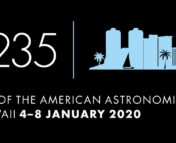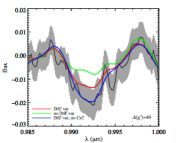In this series of posts, we sit down with a few of the keynote speakers of the 235th AAS meeting to learn more about them and their research. You can see a full schedule of their talks here, and read our other interviews here!
Making My (Milky) Way Downtown

To extragalactic astronomers, the Milky Way can seem like a boring place, especially compared to its flashier cousins like starbursts and quasars. But over the last decade, as we’ve measured the motions of stars in the Milky Way with greater precision, it’s become increasingly apparent that our galaxy is an extraordinarily complex environment, and that we’ve only just begun to scratch the surface of the field of galactic dynamics.
No one knows this better than Prof. Jo Bovy. Bovy, a professor and Canada Research Chair in Galactic Astrophysics at the University of Toronto, is the 2020 winner of the Helen B. Warner Prize, awarded “for a significant contribution to observational or theoretical astronomy.” He will discuss his work at #AAS235 with his keynote lecture “Not Your Grandparents’ Galaxy: The Milky Way in the Era of Large Surveys.”
As his talk title suggests, Bovy studies the Milky Way using datasets from large surveys. “The most exciting thing for me is that [large surveys] allow you to answer these big questions in astrophysics and physics,” he says. “What is dark matter? How does our galaxy form and evolve? For these, we need to really map the Milky Way in great detail to answer these questions from the astrophysical side, and that’s only really possible with these surveys.”
The Devil is in the Details
Much of Bovy’s work focuses on Galactic structure. We’ve known about the basic “fried egg” structure of the Milky Way for quite a while: a central yolk-like bulge is surrounded by a relatively thin extended disk, where most stars live in spiral arms. But the details of this structure are still open questions.
For example, Bovy says, “it’s only been 30 years since we’ve known that the Milky Way has a bar,” and only recently have astronomers begun to develop a consensus on key properties of the bar, like its rotation, shape, and formation. This might seem like a relatively small modification to our models of Galactic structure—but as Bovy points out, “the bar has a big effect on the evolution of the galaxy.”
Even smaller details in the Milky Way’s anatomy can be used to answer outstanding physical questions—like the identity of dark matter. “For me, this is one of the most exciting areas in astrophysics,” Bovy says. “One of the best ways we have to look for clues on what dark matter might be is to see how it clusters on very small scales.” According to our current best cosmological model, ΛCDM, cold (i.e., non-relativistic) dark matter should cluster on very small scales—small clumps or “subhalos” of dark matter the mass of stars or even planets. But these dark matter subhalos are, well, dark. They’re not luminous the way stars are, so the best way to find them is to observe them indirectly through their gravitational interactions with luminous matter.
Recently, Bovy’s group has been hunting for these indirect signals using stellar streams (see figure). These streams are dynamically “cold” (meaning random motions of stars in a stream are small compared to the stream’s overall velocity), so small perturbations to a stream’s motion caused by changes in density along the stream can lead to detectable signals. Using large surveys, like Gaia and SDSS Pan-STARRS, Dr. Bovy’s group has found that some of these perturbations are best explained by a population of dark matter subhalos. If these perturbations are indeed caused by subhalos, the existence of this population puts strong constraints on certain models of dark matter, for instance ruling out low-mass warm dark matter particles.
More Data, More (Scientific) Problems
Bovy hasn’t always been interested in large surveys—in fact, he hasn’t always been interested in astrophysics. “I come from a physics background,” he laughs. “I had, to be honest, never really thought of being an astronomer until I was deep into grad school.”
“At first I thought I was going to work in string theory,” Bovy says, but that quickly changed. “I was just looking around for things to do; I worked a little bit on nonlinear dynamics and chaos, but then we had to do an experimental physics project.” Bovy picked an observational astronomy project with Prof. David Hogg, who became his advisor. “Before that, I had never thought very much about astrophysics, but then I got really excited by it.” Bovy ended up doing most of his graduate work in galactic dynamics and structure. “I liked the coding, the data science aspect,” he explains.
When asked what advice he would give to students, Bovy has two recommendations. First, he says, “I would do more work on background reading. […] I had very little formal education in astrophysics. Reading older papers that are important would have helped me get a better understanding of the field.” (For those of you interested in taking this advice, we recommend Astrobites’ summaries of astrophysical classics!)
The second piece of advice? “For me, writing code, making sure it’s clean, it’s documented, it works for you—it’s hard to waste time on that.” Bovy knows this from first-hand experience: while in grad school, he started building up his own set of Python routines that would become the galpy package used for galactic dynamics calculations. “I had been working on software packages before, so I just started [getting] these routines together for later use. […] And then it just kind of snowballed from there.” This year, galpy is celebrating its 10th anniversary!
Bovy summarizes his advice: “As a student, it’s important to not worry too much about getting out paper after paper and reading just the recent literature, but it’s important to both build up this background knowledge and this set of skills.” If you’re interested in building up your own background knowledge about the Milky Way, come check out Dr. Bovy’s plenary talk at 11:40AM on Monday, January 6 at #AAS235!



